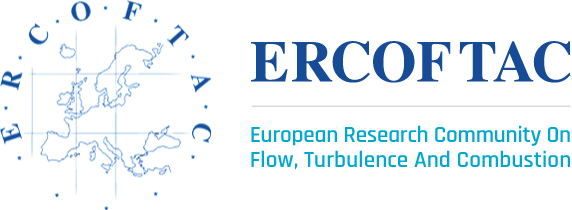Mini-Symposium on Swirling Flows, in the context of the EFMC6
Stockholm, Sweden, June 29th 2006
A one-day mini-symposium on swirling flows was hosted on June 29th 2006 as a part of the 6th EUROMECH European Fluid Mechanics Conference in Stockholm, Sweden. The fluid mechanics conferences, which take place every third year, are the major gathering of the European fluid mechanics community and are organized by the European Mechanics Society EUROMECH. As an integral part of the sixth conference, the co-chairmen of ERCOFTAC’s SIG no 36 on Swirling Flows were entitled to organize a one-day mini-symposium as one of eight parallel sessions.
Altogether 17 papers were presented at the mini-symposium, of which the two first were invited presentations of 30 minutes duration. In his opening talk on tornado-like vortices, Professor D. Etling (University of Hannover) first gave an overview of the occurrence of different kinds of columnar vortices in the atmosphere, and in particular examples of atmospheric tornados. The most essential properties of atmospheric tornados can be investigated in laboratory experiments and results from such recent investigations in Hannover were given. The second invited talk was given by Professor V. L. Okulov (Technical University of Denmark). He gave an overview of and introduction to his analytical investigations of individual and multiple helical vortex filaments where for instance Kapteyn’s series representations were used (see e.g. J. Fluid Mech., Vol. 521, p. 319, 2005). By means of a stability analysis, he could distinguish between right- and left-handed helical symmetry.
In addition to these two invited talks, altogether 15 presentations (15 minutes each) were given. These were concerned with a variety of problems associated with rotating and/or swirling fluid motions. Of these, seven talks were devoted to either external or confined swirling flows. The problems addressed spanned from non-linear wave phenomena in columnar flows to vortex-rope formation in hydroturbine draft tubes. The problems were studied experimentally (as at Ruhr Universitat Bochum, Germany and at The Royal Institute of Technology in Sweden), theoretically (Institute of Thermophysics, Novosibirsk, Russia) or by means of RANS-based CFD (University of Karlsruhe and Université Paris VI).
Another group of presentations dealt with flows in rotating systems where the Coriolis force plays an important role when the flow is observed from a reference system rotating with the flow, like e.g. in turbomachinery. These investigations spanned from DNS (TU Darmstadt, Germany) via theoretical analyses to laboratory experiments (TU Freiberg, Germany). A group from Niels Bohr Institute and Technical University of Denmark showed some elegant new flow visualisations which revealed the somewhat unexpected existence of polygon-patterns on the free surface of a rotating fluid.
A third group of presentations (3 talks) were concerned with three-dimensional effects in free shear flows. These included experimental studies on three-dimensional shear layers (University of Arizona, USA) using hot-wire anemometry and particle image velocimetry and computational studies of laminar and turbulent vortex shedding behind circular cylinders with wall rotation (IMFT Toulouse, France) and with cellular shedding (NTNU Trondheim, Norway).
The mini-symposium was concluded with a plenary discussion on the fundamental and practical importance of swirling flows. It was generally agreed that a yearly meeting of the steering committee of the SIG, together with a symposium every second year, would be appropriate in order to stimulate and coordinate swirling flows activities at a European level.
List of presentations (in order of appearance)
The one-page abstracts are available on pages 387 - 403 in Volume 2 of the electronic book-of-abstracts on http://www2.mech.kth.se/efmc6/index.html
- D. Etling: Laboratory experiments on tornado-like vortices
- V.L. Okulov: Theory of helical vortices
- P.A. Kuibin, V.L. Okulov & I.M. Pylev: Modelling of the flow structure in a hydroturbine draft tube through integral characteristics
- J. Ko & S. Zahrai: Effects of swirl number magnitudes on the accuracy of the linear and quadratic Reynolds stress transport models
- L. Taubert, P. Varghese, D. Knyazev & I. Wygnanski: On three dimensional shear layers
- R. Elakoury, M. Braza, G. Harran & R. Perrin: 2D and 3D flow past a rotating cylinder at moderate Reynolds numbers
- V.D. Narasimhamurthy, H.I. Andersson & B. Pettersen: Cellular vortex shedding in the wake of a tapered cylinder
- Ch. Brücker: Effect of background rotation on the structure of sphere wake flow
- T. Weller, K. Schneider, M. Oberlack & M. Farge: DNS and wavelet analysis of a turbulent channel flow with streamwise rotation
- C. Hills & O. Hall: Eddies induced between two rotating, coaxial cones
T. Bohr & P. Hersen: Polygons on a rotating fluid surface - W. Herreman, L. Lacaze, M. Le Bars, S. Le Dizès & P. Le Gal: Magnetic dipole induction by the spin-over mode of the elliptic instability in a rotating liquid metal sphere
- N. Bleier & V. Vasanta Ram: Influence of a strong swirl on the stability of an annular flow
- J. Hussong, N. Bleier, & V. Vasanta Ram: The structure of the critical layer of a swirling annular flow in transition
- M. Garcia-Villalba, J. Fröhlich & W. Rodi: Coherent structures in annular and co-annular swirling jets
- R. Örlü: Mixing characteristics in the near-field of a swirling jet
- A. Ni: Nonlinear wave structures in swirling columnar flows
Related Events
Sorry, there are currently no articles to show.
To view a full list of current events, click here
Related News
Sorry, there are currently no articles to show.
To view a full list of current news, click here
